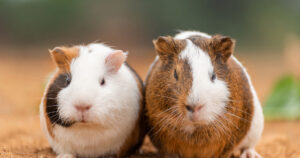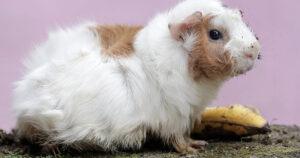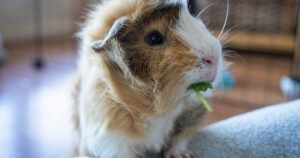Cotton candy grapes have become a popular novelty fruit in recent years. Their taste remarkably mimics the sugary sweet flavor of spun cotton candy.

As a guinea pig owner, you may be curious whether these unique grapes make a suitable occasional treat for your cavy.
While guinea pigs can eat cotton candy grapes, there are some important factors to consider regarding serving sizes, frequency, and potential health risks.
An Overview of Grapes for Guinea Pigs
To understand cotton candy grapes specifically, it helps to first review general grape guidelines for guinea pigs.
Grapes contain natural sugar, so should only be fed in moderation. The average grape has around 1 gram of sugar per piece of fruit. That may not seem like much, but for a tiny guinea pig it can add up quickly.
Too much dietary sugar can lead to obesity, diabetes, gastrointestinal upset, and other health complications in guinea pigs. Their digestive systems are quite sensitive.
Grapes do offer some nutritional benefits, including:
- Vitamin C
- Antioxidants
- Potassium
- Vitamin K
However, guinea pigs also need ample hay and pellets to balance their diet. The bulk of nutrition should not come from sugary fruits.
Most experts recommend limiting guinea pigs to 1-2 small grapes per week. The grapes should be washed, cut into small pieces, and seeds removed to lower choking hazards.
Serving Suggestions for Grapes:
- 1-2 pieces per guinea pig weekly
- Wash thoroughly before serving
- Cut grapes into halves or quarters
- Remove any seeds
- Introduce new treats slowly
As long as grapes are provided in strict moderation, they can be a healthy component of a varied guinea pig diet. But what about cotton candy grapes specifically?
What are Cotton Candy Grapes?
Cotton candy grapes are a hybrid variety of grapes developed to replicate the flavor and experience of eating spun cotton candy.
They were produced by cross-pollinating two existing types of grapes – the Vitis vinifera sweet grape variety and Vitis labrusca Concord grapes.
After years of experimentation, horticulturists were able to create a new grape variety that mimics the taste and scent of cotton candy. The sugar content was increased to achieve the signature sweetness.
So while cotton candy grapes are all natural with no artificial additives, they do contain around 12% more sugar than regular table grapes. The extra sweetness is what gives them their novelty appeal.
When cotton candy grapes first emerged on the market, they were quite rare and expensive. But production has expanded over the past decade, making them more widely available.
Still, these designer grapes usually cost 2-3 times more than regular grapes. Their production requires more meticulous growing conditions compared to common grapes.
Now that you understand what cotton candy grapes are, let’s explore how suitable they are as guinea pig treats.
Can Guinea Pigs Eat Cotton Candy Grapes?
Yes, guinea pigs can eat cotton candy grapes. But there are some important caveats regarding serving sizes and frequency.
The bottom line is that cotton candy grapes should be an occasional treat, not a regular part of your guinea pig’s diet.
While the extra sugar content might seem minimal, guinea pigs are so small that a little extra sugar goes a long way. Their digestive health depends on strict moderation of sugary foods.
With the right precautions, cotton candy grapes can be a fun way to surprise your guinea pigs with a sweet snack once in a while. Just be sure to account for the additional sugar content compared to regular grapes.
Key Takeaway: The extra sugar in cotton candy grapes means portion control is very important for guinea pigs. Only small amounts should be fed occasionally.
Tips for Feeding Cotton Candy Grapes:
- Limit to 1-2 small cotton candy grapes per guinea pig weekly
- Wash and cut grapes into small pieces before serving
- Remove any seeds to lower choking risk
- Introduce new foods slowly and watch for signs of GI upset
- Discontinue use if soft stool or diarrhea occurs
Always supervise your guinea pigs when offering new foods. And restrict sugary treats like cotton candy grapes to a few times per month maximum.
Health Benefits of Cotton Candy Grapes for Guinea Pigs
The biggest health benefit cotton candy grapes offer guinea pigs is enjoyment! Guinea pigs love sweet flavors.
Beyond being a tasty treat, cotton candy grapes can also provide:
- Vitamin C – Important for immune health since guinea pigs cannot make their own vitamin C.
- Potassium – Helps nervous system function and hydration.
- Vitamin K – Essential for blood clotting. Also supports bone and kidney health.
- Antioxidants – Help neutralize cell-damaging free radicals.
However, all these nutrients are found in regular grapes too. And the extra sugar outweighs any marginal nutritional boost of cotton candy grapes for guinea pigs.
This is why moderation and portion control are so important when feeding these sweeter grapes. The health risks start to accumulate when served too frequently or in too large of portions.
Health Risks of Cotton Candy Grapes for Guinea Pigs
While cotton candy grapes are not toxic to guinea pigs, their extra sugar content does pose some potential health risks when overfed.
Increased Risk of Obesity
Too many high-calorie, sugary treats lead to weight gain in guinea pigs, just as with humans. Their small size makes guinea pigs prone to packing on excess fat quickly.
Obesity stresses the body, impairs mobility, and contributes to other guinea pig illnesses like heart disease and diabetes.
Blood Sugar Spikes
The excess sugar in cotton candy grapes can cause blood glucose levels to spike rapidly when consumed. Guinea pigs are at risk for developing insulin resistance and diabetes.
Signs of a blood sugar crash after eating sweets can include lethargy, weakness, and incoordination in guinea pigs.
Digestive Upset
Too much dietary sugar throws off the balance of good vs bad gut bacteria in guinea pigs. An overgrowth of harmful bacteria causes tummy troubles like gas, bloating, and diarrhea.
Their sensitive digestive systems can be disrupted by sugary treats fed too often.
Dental Disease
The sticky sugar in cotton candy grapes can cling to guinea pig teeth, promoting decay and other dental disorders. Grapes lack the abrasiveness needed to grind down continually growing teeth.
In the long run, sugary treats contribute to painful dental issues in guinea pigs. Their teeth require high-fiber hay and pellets for proper wear.
For all these reasons, cotton candy grapes should only be an occasional nibble, not a regular part of your guinea pig’s primary diet. Be sure to only offer tiny portion sizes.
How Else Can You Safely Spoil Your Guinea Pig?
Guinea pigs definitely appreciate sweet treats in moderation. Here are some other ways to show your cavy some love while supporting their health:
- Timothy Hay Cubes – Compressed cubes of tasty timothy hay for foraging. All the benefits of hay in a fun shape!
- Oat Hay – Lower in calcium than alfalfa hay. Oat hay offers more variety.
- Romaine Lettuce – The lettuce leaves make fun “bowls” for serving up tasty herbs.
- Fresh Herbs – Parsley, cilantro, dill, mint, and basil make healthy, low-calorie treats. Rotate different herbs.
- Melon – Tiny cubes of honeydew or cantaloupe offer sweetness with more nutrition than grapes.
- Berries – Strawberries, raspberries, and blueberries provide antioxidant power with less sugar than grapes.
- Bell Peppers – Red, yellow, or green peppers offer vitamin C and crunch appeal.
- Edible Flowers – Mini flower treats like pansies, roses, and violets. Choose pesticide-free flowers.
With a bit of creativity, you can find lots of alternatives to provide your guinea pig with variety and excitement at snack time. Just remember, fruits and treats should be limited to no more than 10% of their overall diet.
FAQs
Can guinea pigs eat cotton candy grapes daily?
No, cotton candy grapes should not be given daily. 1-2 times monthly is recommended at most due to their extra sugar content.
Are cotton candy grapes safe for diabetic guinea pigs?
Best to avoid. The extra sugar can further disrupt blood glucose levels in diabetic guinea pigs.
Can baby guinea pigs eat cotton candy grapes?
No. Babies under 6 months should not have any high-sugar fruits yet. Stick to unlimited hay, alfalfa pellets, and mom’s milk for young guinea pigs.
What if my guinea pig eats too many cotton candy grapes?
Contact your exotics vet if your guinea pig consumes a large amount of cotton candy grapes. Signs of sugar overdose include diarrhea, lethargy, gas, and dehydration. The vet may administer IV fluids and gastrointestinal protectants. Prevent access to sweets in the future.
Are cotton candy grapes toxic to guinea pigs?
No, cotton candy grapes are not toxic, but overconsumption can certainly lead to health problems in guinea pigs. Be sure to portion tiny pieces and only offer 1-2 times monthly maximum.
Can guinea pigs eat cotton candy grapes dried or frozen?
No. Dried and frozen grapes pose an even higher choking risk for guinea pigs. Plus frozen foods can cause digestive upset. Always stick to fresh, raw treats.
Conclusion
Cotton candy grapes present a tasty way to offer your guinea pig something indulgent and different from their usual diet. However, these designer grapes contain extra sugar that requires careful consideration.
While guinea pigs can eat cotton candy grapes on occasion, daily or large portions are ill-advised due to potential obesity, dental disease, blood sugar fluctuations, and gastrointestinal upset. Follow suggestions for strict moderation.







